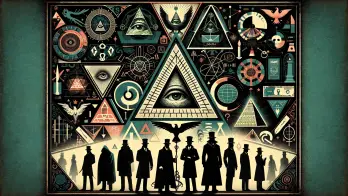Despite consistent ignorance, its supporters have become increasingly agitated and have been gathering material evidence, incontestable proofs, or merely logical arguments that have gradually disturbed the peace of academies, resulting in symptomatic changes in the official position.
What Is the Ancient Aliens Theory?
The ancient aliens theory (also known as ancient astronauts theory) is a controversial hypothesis suggesting that extraterrestrial beings visited Earth in ancient times and made contact with humans, influencing the development of human civilization and technology.
Advocates of this theory contend that proof of these extraterrestrial visitations can be found in ancient texts, artwork, and artifacts.
They point to unexplained phenomena, such as the construction of megalithic structures like the pyramids of Giza or the Nazca Lines in Peru, as potential evidence of alien involvement.
The idea of ancient astronauts first appeared in science fiction during the late 19th to early 20th century, but it gained wider attention in the 1960s, coinciding with the Space Race and the publication of works by Erich von Däniken.
Despite receiving little consideration as a serious hypothesis, critics emerged in the 1970s, discrediting Von Däniken’s claims.
The idea was eventually separated from the UFO controversy by ufologists, and by the early 1980s, little remaining support for the hypothesis could be found.
However, in contemporary times, science remains skeptical.
Einstein’s famous quote on how great scientific discoveries are made is still relevant today. When questioned on this topic during an interview, he replied:
It’s very simple. Everyone knows that certain phenomena are impossible to demonstrate. From time to time, though, a naive person who hasn’t yet heard it appears!
The ancient aliens theory often leads to a phenomenon accurately named by Dr. Hynek as a “breakdown of explanation,” which is characterized in his book “The UFO Experience.”
When the mind is suddenly confronted with truly uncomfortable facts and refuses to integrate them into the usually accepted view of the surrounding world, there is a desperate effort to overcome that breakdown.
This effort is more emotional than intellectual, as the latter would require an honest recognition of our knowledge’s inadequacy.
Behind these strange phenomena and material evidence, there is something that some people need to take into account. Consequently, they are avoided or discredited. These people seek refuge in the world of satisfying explanations.
Although the ancient aliens theory is considered by some as a frontier science, it offers answers to some of the most compelling questions that modern science has yet to solve.
Fundamental Questions to Which Ancient Aliens Theory May Offer Answers
Some questions persistently defy any “new” and “satisfactory” explanations. Here are some questions that the ancient aliens theory attempts to answer:
1) Are all humanoid fossils and archaeological remains of terrestrial origin?
2) Have rational beings from outer space visited us, who intervened positively or negatively, willingly or not, in the development of the human species?
3) What is the true origin of man?
4) Where did ancient peoples obtain their extraordinary technical-scientific knowledge if there were no contacts with advanced civilizations?
5) How and why did prehistoric man learn to leave traces that astound us today?
6) What methods were used to extract, raise, and transport sculptures, stones, and masses of hard rock over hills, deserts, jungles, rivers, or even mountains and then join them perfectly (without mortar) in giant constructions?
7) Why were these massive structures built, adhering to precise rules based on advanced mathematics, architecture, physics, chemistry, and astronomy knowledge?
8) Can the theory that all these sculptures, pyramids, temples, sanctuaries, cities, or even modifications of the environment were the manifestation of the ambition of proud rulers be accepted, or were they dedicated to sacramental divinities?
9) Who inspired cave paintings, sculptures, legends, epics, and poems containing undoubtedly modern objects, advanced technical elements, or physical and astronomical phenomena only discovered or accomplished in our era?
10) What metallurgical technology from the Neolithic or Bronze Age allowed the processing of metals or the production of alloys with aluminum, platinum, steel, and indestructible iron, complicated in their production process and only fully assimilated in the twentieth century?
11) What technique produced stone discs with high cobalt content, electromagnetically charged electric generators, voltaic piles, crystal lenses that are ground to perfection, or better fabrics than today?
12) What incredible technique allowed the cutting of stone to the millimeter and metal to the micron, left radioactive traces, and indicated the use of mercury and titanium for flight apparatus in ancient times?
13) Where did ancient peoples have precise astronomical knowledge of our solar system and stars and distant galaxies (some only discovered in the last decades)?
14) Where did they have the mathematical knowledge that allowed for calculations with fifteen decimals and the solving of geometrical problems in space only accessible to today’s computers?
15) Where did they have the physics knowledge that made possible the description of space flights with their characteristic elements: weightlessness, the effect of acceleration on the human body, or even “time dilation”?
16) How could our ancestors draw precise maps of almost inaccessible regions or entire continents with no aerial cartography observations?
17) Where did our distant ancestors acquire the remarkable anatomical and medical knowledge that enabled them to perform cataract surgeries, trepanations, aesthetic surgeries, amputations, and perfect sutures of bones, treating complicated infectious, internal, circulatory, cardiac, respiratory, or even mental illnesses?
18) What inspired our ancestors to practice mummification on the dead?
19) Why do old legends so categorically affirm the interventions of extraterrestrial beings during the evolution of mankind?
20) How can the description and effect of modern machines or weapons, some even atomic, biological, or radioactive, be explained?
21) How can constructing landing strips, 60 km long markers, 250 m high rock carvings, casemates-dome houses, or tower houses with roof entrances be justified?
22) From where does the strange similarity of the costumes on some cave paintings or bas-reliefs with modern clothing (gloves, boots, baggy or tight pants, sweaters, and overcoats) stem?
23) What inspired the unique scuba and aviator costumes, with helmets equipped with antennas, masks and breathing filters, visors, glasses, metal clips, sealed gaskets, and air tanks, all faithfully represented by Neolithic people?
24) Why did some gods “appear” to people in strange objects and machines powered by fire jets, all provided with wheels, tracks, wings, and projectors, making a thunder-like noise and raising dust during takeoff or movement?
25) Why did the “gods” use sound amplifiers, electric generators, and radioactive weapons when they could have presented themselves in the classic image of gods wearing sandals and holding a scepter, surrounded by rays, and knocking down people by simply raising their hand?
26) Who were the “gods” who could appear and disappear in the blink of an eye?
27) Did primitive people from South America, Central Asia, Oceania, North and South Africa, the Middle East, the Far East, North and South Europe, the Sahara, and the Far North visit each other, or was prehistoric art more unified than it is today?
The Baffling Truths of the Ancient Astronauts Theory
The hypothesis of ancient astronauts, also known as paleocontact, is a theory proposing that extraterrestrial beings visited Earth in ancient times, influencing the development of human civilization and technology.
Proponents of this theory argue that the existence of ancient astronauts can be inferred from gaps in the historical and archaeological records and the presence of artifacts that appear to be beyond the technical capabilities of the cultures with which they are associated.
These artifacts often called “out-of-place artifacts,” include artwork and legends depicting extraterrestrial contact or technologies.
However, many scholars have criticized the ancient astronauts hypothesis, arguing that the lack of documentation or physical evidence cannot be taken as proof of extraterrestrial contact.
Astrophysicist Carl Sagan, for example, dismisses the hypothesis as “pop archaeology,” stating that cases of apparent interest have perfectly reasonable alternative explanations or are simply hoaxes and distortions.
In 1963, Carl Sagan used the Drake equation to propose the possibility of one million intelligent civilizations in the Milky Way, with the nearest one several hundred light years away.
He argued that theoretical propulsion methods like the Bussard ramjet made interstellar travel feasible and explored the idea that Earth may have been visited once during historical times.
Sagan suggested that pre-scientific narratives could offer a reliable means of describing contact with aliens, citing the 1786 encounter between European and Tlingit cultures as an example of how brief contact with an alien civilization could be recorded accurately if certain circumstances were met.
Sagan also cited Babylonian accounts of fish-like beings, known as apkallu, who emerged from the sea to teach early Sumerians agriculture, mathematics, and the arts, as an instance of paleocontact deserving closer scrutiny.
Although the authors emphasized that these ideas were speculative and not intended to establish claims of past visitation, they were repeated and expanded in the popular book Intelligent Life in the Universe, co-authored with Soviet astrophysicist Iosif Shklovsky and published in 1966.
However, in his 1979 book Broca’s Brain, Sagan disapproved of the uncritical writers who built on these ideas as valid evidence of extraterrestrial contact.
He reiterated his earlier conclusion that while extraterrestrial visits to Earth were possible, they were unproven and improbable.
Sagan also argued that conventional hypotheses could easily explain many legends, artifacts, and purported out-of-place artifacts cited in support of ancient astronauts theory.
Erich von Däniken
Erich von Däniken was a prominent advocate of the ancient astronauts theory in the late 1960s and early 1970s.
He gained a large following with the publication of his best-selling book “Chariots of the Gods?” in 1968, followed by sequels.
According to von Däniken, certain artifacts found in various cultures required more advanced technology than what was available at the time.
He argues that these artifacts were either constructed by extraterrestrial beings or by humans who were taught by them.
Such artifacts include Stonehenge, Pumapunku, the Moai of Easter Island, the Great Pyramid of Giza, and the ancient Baghdad electric batteries.
Von Däniken also argues that ancient art and iconography worldwide depict air and space vehicles, non-human but intelligent creatures, and anachronistically advanced technologies.
He believes that geographically separated cultures sharing similar artistic themes suggest a common origin.
However, his interpretations of certain artifacts have been disputed, such as his claim that the sarcophagus lid of the Maya ruler Pacal the Great represented a seated astronaut.
Von Däniken also suggests that many religions were inspired by encounters with extraterrestrial beings, with humans viewing them as supernatural or divine.
He believes that religious texts contain references to alien visitors, such as Ezekiel’s vision in the Old Testament.
Critics of von Däniken’s work argue that his claims are unfounded and that he misrepresents data.
Christian creationists are particularly critical of his hypotheses. Some have attempted to discredit his work, such as Clifford A. Wilson’s book “Crash Go the Chariots.”
In “Chariots of the Gods?,” von Däniken claimed that the Nazca Lines in Peru looked like an airfield when viewed from above.
However, he later admitted that they could have been created using a system of coordinates.
Critics argue that von Däniken exhibited confirmation bias and that his interpretations of artifacts may have been influenced by his beliefs.
They suggest that readers may be more likely to associate these features with extraterrestrial origins if they are presented in a book about aliens rather than from a civilization that existed on Earth.
Evidence Supporting the Ancient Astronauts Theory
Proposed evidence for ancient astronauts theory often cites the existence of ancient structures and megalithic ruins, such as the Giza pyramids of Egypt, Machu Picchu in Peru, Baalbek in Lebanon, the Moai of Easter Island, and Stonehenge in England.
Some proponents argue that the precision with which these structures were constructed and the distances over which the building materials were transported could not have been accomplished by the people of the time using the technology available to them.
However, mainstream archeologists reject these claims, citing experiments that have successfully moved megaliths up to at least 40 tons and suggesting that larger megaliths could have been moved with a larger workforce and known ancient technology.
Pyramids of Egypt
In particular, the Giza pyramids of Egypt are often cited as evidence of extraterrestrial influence.
However, archeological evidence demonstrates the ancient Egyptians’ long cultural trajectory and developmental processes.
For example, Egyptian tombs evolved from mounds of earth covering important village leaders to single-story, mud-brick structures called mastabas, eventually leading to the Step Pyramid construction at Saqqara.
It was only when pharaoh Sneferu that the pyramid structure transitioned to a true pyramid, like the well-known pyramids of Giza.
Records, including a papyrus document resembling a logbook kept by inspector Merer, demonstrate that the Great Pyramid was constructed by the ancient Egyptians.
The Moai Statues
Similarly, the Moai statues of Easter Island were moved from the Rano Raraku quarry to their current locations. Some ancient astronauts theory proponents have suggested that the native Rapa Nui people used “mana” to make the statues walk.
However, in 1982, Czech engineer Pavel Pavel and a group of sixteen people used a replica concrete moai to demonstrate that the massive statues could be easily moved by a small group of people using the “refrigerator method,” in which ropes are tied to the statue and it is pulled and twisted back and forth to make it move in a walking motion.
Religious and Cultural Practices
Some ancient cultures, such as the ancient Egyptians and some Native Americans, artificially lengthened the skulls of their children.
While some ancient astronauts theory proponents propose that this was done to emulate extraterrestrial visitors, whom they saw as gods, archeological evidence suggests that it was likely due to cultural or religious practices.
Among the ancient rulers depicted with elongated skulls are pharaoh Akhenaten and Nefertiti, but the elongation is now believed to be the result of a familial disease caused by marriage between family members, especially siblings, which was common in ancient Egyptian royal families.
Of course, not every fantastic legend, unusual stone, or strange archaeological discovery should be considered evidence supporting the hypotheses of the ancient aliens theory.
However, can it be justified that they “should not be deprived of mystery”? Should we abandon understanding?
Let’s remember the statement of a “scholar” from 500 years ago: “It is nowhere written in the Bible that the Earth revolves around the Sun. Consequently, any such assertion is the work of the devil!”
At Ancient Theory we only use trusted sources to document our articles. Such relevant sources include authentic documents, newspaper and magazine articles, established authors, or reputable websites.
- Ancient astronauts. wikipedia.org. [Source]
- Jonas Richter - Traces of the Gods: ancient astronauts as a Vision of Our Future.
- Morgana Sommer - Pseudoarchaeology and the ancient astronauts theory: an analysis of a modern belief system.
- Jonas Richter - Traces of the Gods: ancient astronauts as a Vision of Our Future. Brill, 2012.





